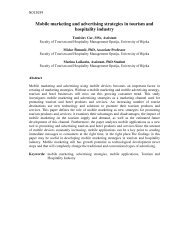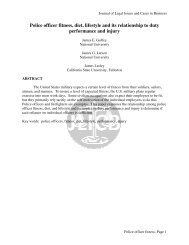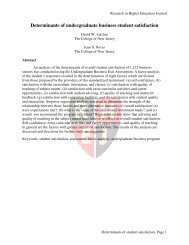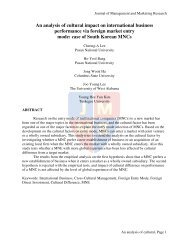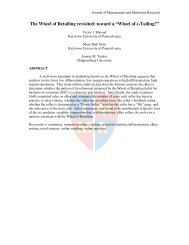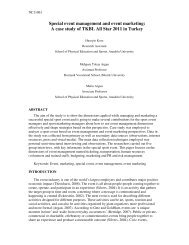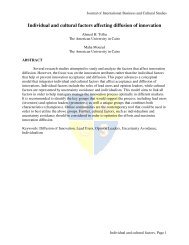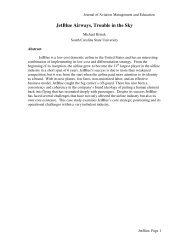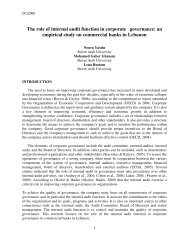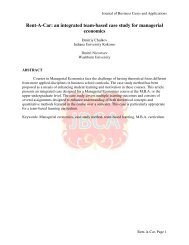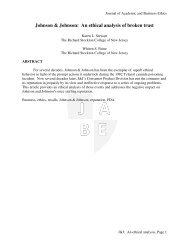Need-Based Segmentation Analysis of University Career Services ...
Need-Based Segmentation Analysis of University Career Services ...
Need-Based Segmentation Analysis of University Career Services ...
You also want an ePaper? Increase the reach of your titles
YUMPU automatically turns print PDFs into web optimized ePapers that Google loves.
Research In Higher Education Journal<br />
this group would likely be interested in proven techniques for dealing with rejection (e.g.,<br />
sending a carefully written thank you letter in order to qualify for future consideration)<br />
(McCorkle et al., 2003). Our fourth segment, the high-touches, should also respond well to<br />
targeted <strong>of</strong>fers <strong>of</strong> help with job search strategies.<br />
High-touches<br />
Clearly, high-touches place the most importance (40.4) on getting help with job search<br />
strategies. They likely do not believe that they can devise an effective job search strategy on their<br />
own. Although they see themselves as being career oriented (4.43) they may be at a loss to<br />
explain why they have had difficulty in landing jobs. We conclude that they are having little<br />
success at finding a job because <strong>of</strong> (see Table 4) their relatively low success ratios for interviews<br />
(.01). It simply follows, then, that high-touches are moderate users <strong>of</strong> career services and seek<br />
tailored job search strategies and one-on-one interaction with UCSC personnel.<br />
High-Touches Strategy: Tailor Appeals to Stages <strong>of</strong> <strong>Career</strong> Decision-Making and Major<br />
Morgan and Ness (2003) argue that career counseling programming should be tailored<br />
more effectively to the career decision-making needs <strong>of</strong> first-year students to lessen career<br />
decision-making difficulties. For example, first-year university students ask career counselors<br />
and other service pr<strong>of</strong>essionals things like: What career should I take? In a similar vein,<br />
McCorkle et al. (2003) found that junior marketing majors “most used job searches” differed<br />
from that <strong>of</strong> seniors. For example, seniors most used sources included “past and/or present<br />
employers, whereas juniors did not. Furthermore, research has shown that liberal arts and<br />
business majors have very different needs (McCorkle et al., 2003; Nell, 2003). Clearly, the<br />
literature suggests that students needing help with job search strategy and desiring one-to-one<br />
interaction, such as our high-touches, should respond well to carefully targeted and highly<br />
customized appeals.<br />
To address the information (and understanding) needs <strong>of</strong> high-touches, UCSCs should<br />
provide more information about various stages <strong>of</strong> career decision-making and corresponding<br />
UCSC services <strong>of</strong>fered. In this way, the process does not seem so daunting and is more akin to<br />
“hand-holding,” (Nadya et al., 2006). Additionally, communications could reduce high-touches’<br />
uncertainty about the process or steps involved in ultimately landing the “dream” job. UCSCs<br />
should also provide more information about services that are targeted at various developmental<br />
levels. For example, freshmen and sophomores are likely to be more interested in services that<br />
help them decide on the right major while seniors and graduate students would be more<br />
interested in receiving information related to their job search (McCorkle et al., 2003; Morgan &<br />
Ness, 2003).<br />
Finally, research suggests the effectiveness <strong>of</strong> college-specific career services appeals.<br />
For example, Nell (2003) finds that “many Arts and Science students have to create their own<br />
career focus because their academic degree and acquired skills can be used in a variety industries<br />
and positions,” (sic). The authors suggest a career services curriculum component and carefully<br />
planned Web site use to address some <strong>of</strong> these issues. For example, the <strong>University</strong> <strong>of</strong> Missouri at<br />
Columbia has a course named “Transitions from College to Work,” (Nell, 2003). McCorkle et al.<br />
(2003), in their study <strong>of</strong> marketing students, recommend that colleges <strong>of</strong> business start selfmarketing<br />
instruction early (e.g., in the Principles <strong>of</strong> Marketing course), and strengthen ties with<br />
<strong>Need</strong>s-<strong>Based</strong> <strong>Segmentation</strong> <strong>Analysis</strong>, Page 15



